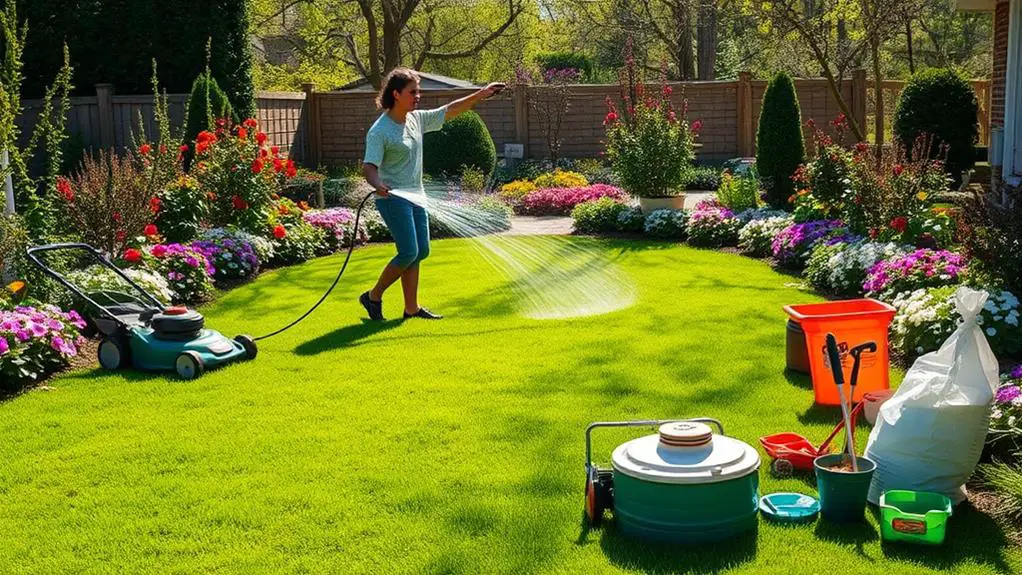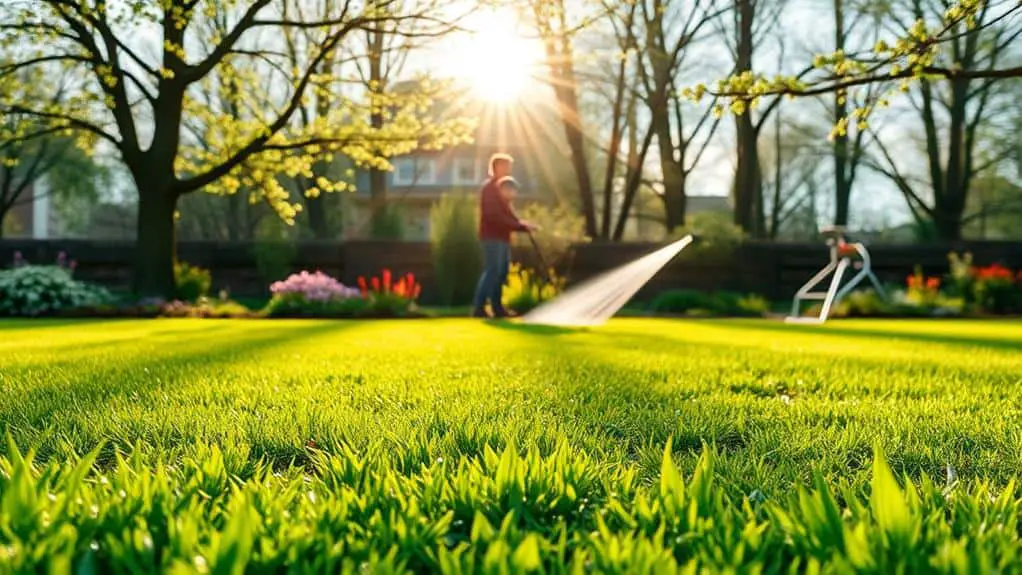When To Start Watering A Lawn In Spring
As spring approaches, you might wonder when it's the right time to start watering your lawn. The key is monitoring soil temperatures, which should be between 50-60°F. Starting too early can stunt root growth and invite fungal problems, while waiting too long might stress the grass. You'll need to take into account your local climate, rainfall patterns, and a few more essential factors. So, how do you guarantee your lawn gets exactly what it needs for ideal health and growth? There are several strategies and tips you can use to make the best decision.
Importance of Spring Watering

Spring watering is essential for shifting your lawn from dormancy to active growth. For effective spring lawn care, establish a watering schedule that provides at least an inch of water per week. This consistent moisture supports healthy growth by promoting deep root development and nutrient absorption.
Start watering when soil temperatures reach 50-60°F, ensuring your grass is ready for irrigation.
Timing is vital; premature watering can create shallow roots and increase the risk of fungal issues. Regularly check local weather patterns to adjust your watering. High spring rainfall might reduce the need for extra irrigation, while dry spells will require additional watering.
Understanding Your Climate
Understanding your climate is essential for effective lawn care. In North Texas, hot summers and mild winters impact when and how often you should water your lawn.
Early spring, around March, is typically when grass starts to come out of dormancy. Understanding local weather patterns helps you determine the best watering schedule.
This region's climate variability, including droughts and heavy rainfall, means you need to be flexible. Keep an eye on temperature fluctuations; when soil temperatures rise to around 55°F, your grass is ready for watering.
Ideal Soil Temperature

Knowing your climate sets the stage for understanding when to water your lawn, but the soil temperature is a key factor that can't be overlooked.
Grass growth typically begins when the soil temperature reaches between 50-60°F. For instance, in Northern New Jersey, this usually happens by late April. Monitoring local conditions is essential.
When soil temperatures are below 55°F, the grass may not awaken properly, making early watering ineffective. Warmer soil promotes quicker and healthier growth, helping your lawn recover from winter.
Regularly checking the soil temperature guarantees that your watering schedule supports a vibrant, healthy lawn. By paying attention to this detail, you can assure a lush, green start to your spring gardening season.
Signs Your Lawn Needs Water
As the weather warms up, it's crucial to recognize the signs that your lawn needs water to maintain its health and vibrancy.
Look for dull green or bluish-grey grass blades, as these indicate dehydration. If your footprints remain visible after walking, it's a clear sign your lawn needs water.
Dry, crumbly soil points to critically low moisture levels. Also, watch for curled grass blades and brown patches, which signal distress.
Check the top 4-6 inches of soil with a screwdriver or moisture meter to see if it's dry. A healthy lawn typically needs an inch of water per week, so start watering your lawn when you see these signs to keep it thriving.
Optimal Watering Schedule

Establishing an ideal watering schedule for your lawn in spring is essential for promoting healthy growth and resilience.
Start watering when soil temperatures reach 50-60°F, signaling grass growth. Aim to provide one inch of water per week, adjusting based on rainfall and soil moisture.
It's best to water early morning to reduce evaporation and minimize the risk of fungal diseases. Consistent monitoring of soil moisture is key; begin watering when the top inch of soil is dry. This encourages deep root development and overall lawn health.
During peak summer months, you might need to water more frequently, but always consider current weather conditions and your grass type to keep your lawn thriving.
Avoiding Common Mistakes
Avoiding common mistakes when watering your lawn in spring is essential for maintaining its health and appearance.
Here's what you should watch out for:
- Watering too early: Watering before soil temperatures reach 50-60°F can result in shallow roots and fungal growth.
- Ignoring signs: If your lawn is showing signs like dryness in the top inch of soil or dull grass blades, it's a sign you need to water. Ignoring these signs can harm your lawn.
- Overwatering: Overwatering, especially in early spring, can suffocate grass roots and promote diseases like root rot.
Tips for Effective Watering

Watering your lawn effectively in spring sets the stage for a lush, healthy yard throughout the warmer months.
The best time to start watering is early in the morning. This reduces evaporation and helps prevent fungal diseases. Aim to provide about 1 inch of water per week, adjusting for rainfall and soil conditions. Use a rain gauge to measure rainfall accurately.
Avoid watering during windy weather conditions since it can cause uneven water distribution. Check soil moisture by inserting a screwdriver or using a soil moisture meter. Confirm the top inch of soil is dry before you water.
Dealing With Drought Restrictions
Facing drought restrictions can be challenging for maintaining a healthy lawn, but staying informed about municipal water regulations is essential.
When facing drought conditions, you'll need to adjust your watering habits to comply with local rules and still care for your lawn. Here are three tips to help:
- Deep Watering: Water deeply but less frequently. This encourages roots to grow deeper and helps your lawn use water more efficiently.
- Monitor Water Use: Keep track of the amount of water per week you're allowed under municipal water restrictions, ensuring you don't exceed it.
- Drought-Tolerant Plants: Consider incorporating drought-tolerant landscaping options to reduce water usage while keeping your lawn looking great.
Additional Lawn Care Practices

In addition to managing water usage, maintaining your lawn's health involves several vital practices.
Regular lawn maintenance, including timely mowing, aeration, and fertilization, keeps your lawn actively growing and healthy. Aerating in early spring improves soil compaction, helping water and nutrients reach the roots better.
Fertilization, tailored to your grass and soil's needs, should be done from late spring to early fall.
Watch for signs of stressing the grass, like wilting or browning, and adjust your care as needed.
Weed control is also important, as it reduces competition for water and nutrients.
Expert Resources and Advice
To guarantee your lawn thrives, leverage expert resources and advice tailored to your specific region.
Understanding your local climate and soil moisture levels is essential, especially in early spring. Consulting local experts can help you determine the best watering schedule.
Here are three key steps:
- Check Soil Temperature: Verify soil temperatures are between 50-60°F before starting irrigation.
- Monitor Moisture: Use a soil moisture meter or a screwdriver to check moisture at a depth of 4-6 inches.
- Stay Weather-Aware: High rainfall in early spring can reduce the need for watering, so keep an eye on forecasts.
Frequently Asked Questions
When Should I Start Watering My Lawn in the Spring?
You should start lawn care by watering your lawn when the top inch of soil is dry. Monitor weather patterns and soil moisture, ensuring soil temperatures reach 50-60°F. Different grass types may influence the specific timing.
When Should You Start Watering Plants in Spring?
You should start watering plants in early spring when the top inch of soil dries out. Ideal watering supports spring growth and plant health. Monitor soil moisture and guarantee temperatures reach 50-60°F to promote healthy roots.
What Is the Earliest Time to Water Your Lawn?
You can start watering your lawn in early March. Use proper lawn watering techniques and consider spring weather effects, soil moisture levels, and grass type. Confirm the soil temperature reaches 50-60°F to avoid issues.
When Should I Turn on Irrigation in Spring?
Turn on your irrigation system in early spring when soil moisture indicates dryness and grass growth begins. Pay attention to weather patterns and guarantee soil temperatures are around 50-60°F for ideal results. Avoid overwatering by monitoring rainfall.
Conclusion
You've got this! Start watering your lawn in spring when soil temperatures hit 50-60°F, usually between late March and early April. Keep an eye on soil temps and adjust based on your local climate. Remember, aim for about 1 inch of water per week. By following these tips and paying attention to your lawn's needs, you'll help it grow strong and healthy. Happy gardening!







